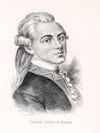, officer in the colonial regular troops; b. 6 June 1703 at Fort Frontenac (Kingston, Ont.) (he received the public ceremonies of baptism in Montreal on 21 June 1704), son of Jean
during the campaign directed by Frontenac [Buade*] against the Iroquois. For most of his life, he lived in Quebec’s
tactics.
Fort Frontenac (Kingston, Ont.) had fallen in August, however, food supplies were low, Indian allies were deserting, the season was late, and
Contrecoeur. Two years later, Duplessis was appointed commandant at Michilimackinac, and on 17 March 1756 he was appointed town major of Montreal. In August 1758, from Fort Frontenac (Kingston
Montagne and Lorette mission Indians in Buade* de Frontenac’s expedition against the Iroquois. In 1714, with
Fort Duquesne. His group left Lachine for the disputed Ohio country at the opening of navigation, 20 April, and arrived at Fort Frontenac (Kingston, Ont.) at the month’s end. Embarking in two
.
He went two days later to Montreal, then on to Fort Frontenac (Kingston, Ont.), where he arrived on 24 June to take part in the operations against Fort Chouaguen (Fort Oswego). On 11 July he
Montreal and Fort Frontenac (Kingston, Ont.); and it was a base for incursions against targets in the Albany-Oswego area. The establishment – its Indian population was about 500 in 1756 – had been
of lieutenant he took part in Lieutenant-Colonel John Bradstreet*’s expedition which captured and destroyed Fort Frontenac (Kingston
one another. Frontenac [Buade*] told the Miamis in 1697 that Michipichy and another Huron chief, Le Baron, had
Fort Frontenac (Kingston, Ont.). Montcalm joined them on 29 July. Before leaving Montreal he had expressed grave misgivings about the expedition, but the main problem proved to be nothing more than
ma thesis, University of Maine, Orono, 1970). Parkman, Count Frontenac and New France (1891), 348–51; Half-century of conflict, I. W. D. Williamson
.
Ononwarogo recruited Indians to accompany Lieutenant-Colonel John Bradstreet* against Fort Frontenac (now Kingston, Ont.) in the summer of 1758
imprisonments, as he was moved in turn to forts Niagara (near Youngstown, N.Y.), Toronto, and Frontenac (Kingston, Ont.), then to Montreal and Quebec. In Montreal on 19 June 1751 he was examined by
regiment was chosen for service in Canada, and was sent to Fort Frontenac (Kingston, Ont.), arriving in July 1755. The quality of the entrenchments he laid out there induced Governor Pierre de
Champlain and Lake Ontario. During the winter of 1755–56, Cressé was sent with a work party to Fort Frontenac (Kingston, Ont.) where he began building two ships, a schooner of ten guns (probably the
[Rigaud*] sent Péan to command at Fort Frontenac (Kingston, Ont.), where he served until 1725. Two years later he was named commandant of Fort Chambly (south of Montreal) where his father-in-law
.
Like several seigneurs of the time, François-Antoine Pécaudy de Contrecœur was to have a long military career. He was a member of the expedition which Governor Frontenac
Mississaugas, to trade with the French and thus dissuade them from taking their furs to the English at Fort Oswego (Chouaguen). Pierre Robinau de Portneuf, who was an ensign at Fort Frontenac (Kingston, Ont.) at
, and captain on 9 June 1708. However, these promotions were not unmerited. In 1695, Governor Frontenac [Buade



